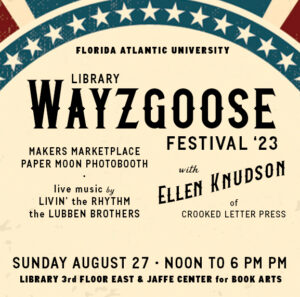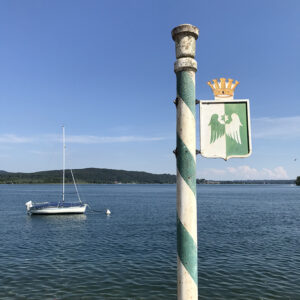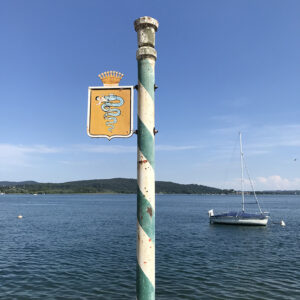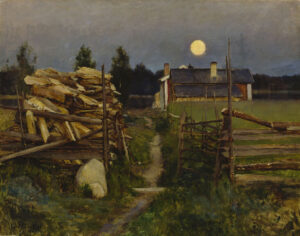If you are longing for cooler weather, here’s a celebration you’ll be pleased about: It’s Bartlemas today, St. Bartholomew’s Day, and his feast day is one that provides a nod of acknowledgment to the subtly shifting wheel of the year and, in particular, of summer beginning to yield to autumn. St. Bartholomew also happens to be a fellow of high importance to book artists like myself: he has his hands in all the major aspects of the Book Arts, these being hand papermaking, letterpress printing, and bookbinding. And it is through these crafts that St. Bart brings his reminder of summer’s waning. If it sounds like the makings of a good story, I’d say you’re right, and how I love a good story! Let’s delve into it, shall we? (I also have an invitation for the locals to an actual St. Bartholomew’s Day Wayzgoose (just a few days after his feast day) at the end, so do read on.)
First of all, St. Bartholomew is one of the patron saints of bookbinders. Not much is known about St. Bartholomew himself. He was one of the Twelve Disciples. He is thought to have traveled to India, but tradition says that he met his end in Armenia in the first century. His martyrdom was a gruesome one––one that by association made St. Bartholomew a patron saint of butchers (a common trade amongst my paternal ancestors) and of tanners and of bookbinders, who very often bind books in leather. I’ll leave the method of his martyrdom, based on those associations, to your imagination, but early bookbinders found it a worthy connexion, hence his patronage of their craft.
And then there is the connexion to papermaking, and for this, we need to go back to the days before glazed glass windows. Back then it was only the wealthiest people who could afford glass windows, while the rest of us, and I’m sure my ancestors are firmly planted in this group, simply had openings in the walls and shutters, perhaps, so that all summer long the shutters would be open, letting in the cool nighttime breezes. As we approach the end of August, though, you’d certainly be thinking about preparing for the chillier days to come in fall and winter, and it was the local papermakers who came to your rescue: they began making special waxed paper this time of year and it was this paper, heavily infused with beeswax, that you would install inside your shutters, to help keep the elements out and the warmth in, and the day to do this task was traditionally today: Bartlemas. Waxed paper windows: they didn’t offer much in terms of warmth, but certainly they were a better alternative than nothing at all. Once this St. Bartholomew’s window paper was made, the papermakers went back to making paper for the printers, clearing out the vats and recharging them with new pulp made from rags that had been retting all summer long.
And now for those printers: It’s the printers who really made a big deal of Bartlemas, especially in England, for it became a day of great celebration. (I might add: no surprise there. I’ve worked with hand papermakers, I’ve worked with bookbinders, and I’ve worked with letterpress printers, and it’s the printers who generally seem most ready to raise a glass with you.) For along with those waxed paper windows came the reality of less natural light. Suddenly it was time again to work by the light of candles and lanterns, and there was no more potent reminder, perhaps, that summer was waning and winter was on its way. And so, all good print shop proprietors would make a celebration of the day, and this celebration came to be known as a “Wayzgoose.” The reason for the name is, sadly, lost to time. But Randall Holme, in 1688, gave us this description of the Bartlemas Wayzgoose:
It is customary for all journeymen to make every year, new paper windows about Bartholomew-tide, at which time the master printer makes them a feast called a Wayzgoose, to which is invited the corrector, founder, smith, ink-maker, &c. who all open their purses and give to the workmen to spend in the tavern or ale-house after the feast. From which time they begin to work by candle light.
To be sure, there was a good quantity of ale consumed as part of the Wayzgoose. In some places, mead, the delightful intoxicating beverage made from honey, was the beverage of choice. Especially in Cornwall, where a Blessing of the Mead ceremony takes place even today at this time of year. Continuing the road of connexions, our friend St. Bartholomew is also a patron saint of beekeepers, and as we continue to gather our stores for the coming winter, it is traditional, too, to bring in the honey crop on his feast day.
My favorite bit of Bartlemas Wayzgoose lore is this: it was on August 27, 2010, that the Jerusalem Post reported that Johannes Gutenberg’s 42-Line Bible, the first book printed from moveable type, was completed on St. Bartholomew’s Day in 1454. Some claim, too, that that first printed book explains why printing has a history of being called the Black Art and why we have personnel in print shops with names like Printer’s Devil. Here’s the story: Johannes Fust, Gutenberg’s business partner, took several of the printed bibles from Mainz, Germany, which is where Gutenberg had his shop, to France, where he sold them, without explaining how they were made. When it was discovered that the books were identical copies of each other, Fust was accused of witchcraft and was briefly imprisoned for that crime. This story always fascinates me!
Prior to the printing press, we mostly got our news through rumors: travelers bringing tales from far off places, neighbors discussing things, embellishing where they saw fit. It was the printing press, though, that ushered in an age of knowledge and literacy and enlightenment, kicking off what came to be called in European history the Renaissance. In the last few decades, we’ve moved beyond the printing press in terms of the dissemination of information and well… progress brings its own set of problems. Now we spread rumors through social media––especially people who hold positions of power––and trusted news sources are overridden, or deemed “fake,” and we find ourselves, nearly 570 years post-Gutenberg, no wiser than Johannes Fust’s accusers.
One thing is certain: if you are a book artist or if you are a book enthusiast, St. Bartholomew’s Day is a very auspicious day for you. For this Bartlemas Wayzgoose, then, certainly we have cause to celebrate books and the people who make them: the papermakers, the printers, the bookbinders, the book artists. This Bartlemas, let us raise our glasses to St. Bart and to all of these good artisans… and to celebrate the printed word and make a pledge to value its importance to good living and to good citizenship. My suggested toast: “Free the books!” We don’t need Big Government––and our Florida government is as big as it gets, folks: school kids here can’t even have nicknames now without their parents’ written consent on file with the School Board (yes, this is state law)––deciding what we should or should not be reading. A free press and the freedom to read and discuss what we see fit: More than ever, the Black Art might just be more important than we think.
CELEBRATE A WAYZGOOSE WITH US!
If you’re here in South Florida, I hope this Sunday you’ll join us at our local Wayzgoose: It’s Florida Atlantic University’s LIBRARY WAYZGOOSE FESTIVAL in Boca Raton, happening from 12 noon to 6 PM at the Jaffe Center for Book Arts and throughout the 3rd Floor East of FAU’s Wimberly Library, which is the Jaffe’s home base. Free admission, free parking. There will be print demos all day with Ellen Knudson of Crooked Letter Press, live music all day (Abasi Hanif and Livin’ the Rhythm drum circle from 12:30 to 2, followed by bluegrass and folk with The Lubben Brothers from 2:30 to close), and the Wayzgoose Makers Marketplace (we’ll be there offering some of our wares–– we’re thinking a shift to autumn in our offerings might be nice, too). There will also be a free paper moon photo booth, a telegraph office, an Exquisite Corpse story project inside a quilted contemplation tent, and doughnuts and coffee and tea. No ale or mead, sorry. CLICK HERE for full details and come see us Sunday!
CELEBRATE OKTOBERFEST WITH US!
While we’re on the subject of shifting toward fall, our next big event currently on the books after this Sunday’s Wayzgoose is Oktoberfest! This year, we are participating in OKTOBERFEST MIAMI at one of our favorite places: the German American Social Club in Miami. Two full weekends of fun: October 13 through 15 and October 20 through 22. We were there last December for their Christmas Market and everyone was so nice to us and we had such a lovely time, we decided to spend Octoberfest with them, too. (The fact that this is an indoor/outdoor Oktoberfest and that our Convivio Bookworks boutique will be located indoors, in air conditioned comfort, is an added perk.) It’s the longest continuously-running Oktoberfest in the country and the largest German cultural event in South Florida, and we’ll be there with tons (perhaps literally, and if not, it’ll certainly feel like it) of our traditional German handicrafts and specialty foods, plus my mom’s Millie’s Tea Towels. You also happen to have just 7 days left to purchase tickets at the reduced pre-sale price: CLICK HERE for details! I think it’s going to be grand!
Happy Bartlemas, everyone!




